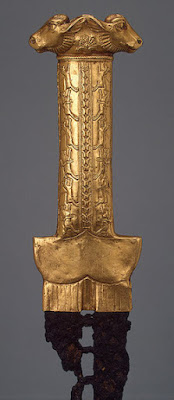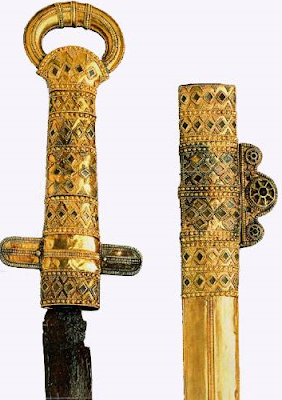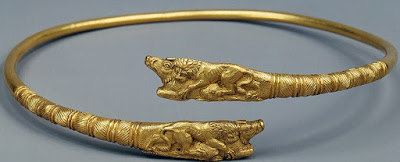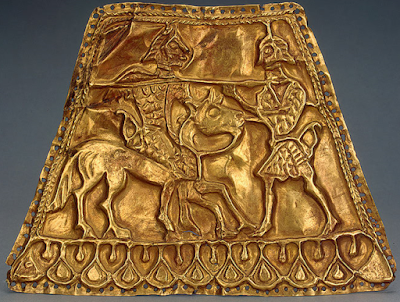 Belt Plaque Gold. Second half of the 7th century BC | The Pereshchepina Treasure is a major deposit of Bulgarian, Sassanian, Sogdian, Turkic and Avarian objects. The hoard was discovered in 1912 in the village of Mala Pereshchepina (20 km from Poltava, Ukraine) by a boy shepherd who literally stumbled over a golden vessel and fell into what is thought to be the grave of Kuvrat, the founder of Great Bulgaria and father of Asparuh, the founder of the First Bulgarian Empire. |  |
 Comb with Scythians in Battle. Gold; cast and chased. Late 5th - early 4th century BC |  Plaque in the Form of the Head Gold; stamped. Scythian. 4th century BC |  Sword Hilt. Gold and iron; chased. Scythian. 5th century BC |
 | The 800 piece trove contains finely crafted gold artifacts that exceeds 21 kg and 50 kg of silver. (42 pounds, 110 pounds) Items ranged from 500 BC to 670 AD and are of Byzantine, Persian and Barbarian origin. Three gold rings are engraved with the monogram of Kubrat, and his 400gm gold patrician buckle and sword were found. Torque (Grivna) Gold; cast, forged, chased. Meotian Culture. Late 4th century BC |  |
 Necklace. Gold; stamped, soldered, filigreed, repousse. Meotian Culture. Late 4th century BC |  Plaque with Scythian Warriors. Gold; repousse. Scythian. 4th century BC |  Facing for a Horse's Frontlet Gold; stamped. Scythian. 4th century BC |
 Overlay for a Goryt (Case for a Bow and Arrows) Gold; stamped. Scythian. 4th century BC  Hand-Washing Vessel: Pitcher and Ladle Poltava Region, Ukraine. Silver gilt |  Overlay for a Wooden Vessel Gold; stamped. Scythian. First half of the 5th century BC  Pair of Boat-Shaped Earrings Gold; forged, stamped, soldered, filigreed. Scythian. 4th century BC |  Goblet Poltava Region, Ukraine 7th century  |

No comments:
Post a Comment